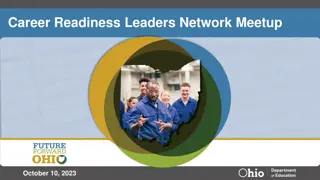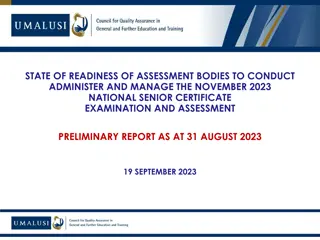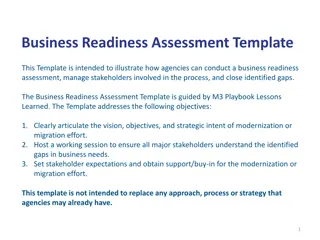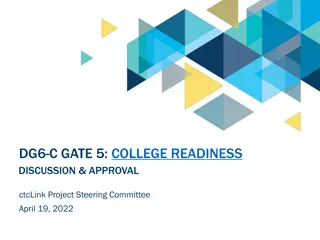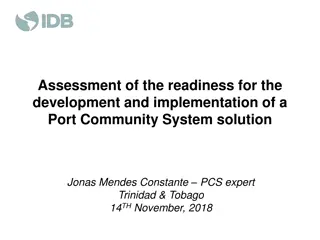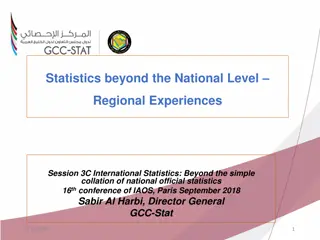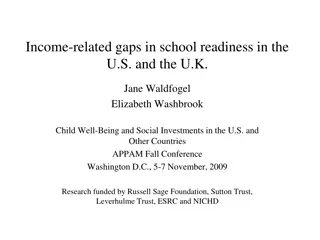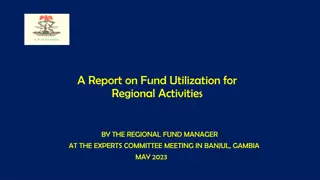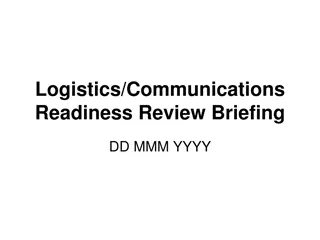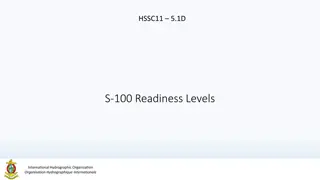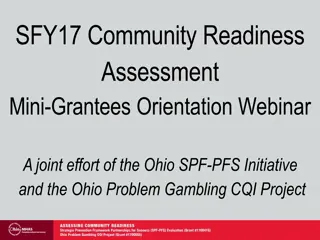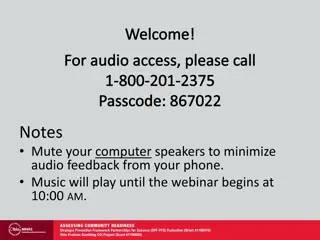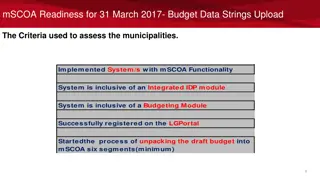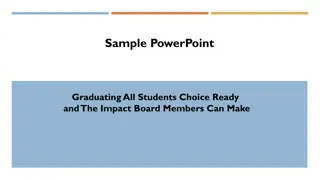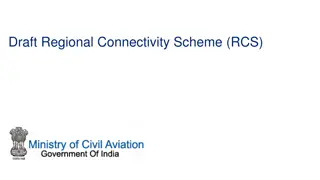
Regional Readiness Guide: Implementing Integrated Family Services (IFS)
Learn about the steps and expectations outlined in the Regional Readiness Guide for implementing Integrated Family Services (IFS) model at the regional level. This guide provides insights, strategies, and key considerations to support the transition towards a new approach in delivering human services. Discover how the IFS model offers a more integrated and flexible way of supporting the development of children, youth, and families in Vermont, emphasizing community engagement, cost-effectiveness, and systematic impact measurement.
Download Presentation

Please find below an Image/Link to download the presentation.
The content on the website is provided AS IS for your information and personal use only. It may not be sold, licensed, or shared on other websites without obtaining consent from the author. If you encounter any issues during the download, it is possible that the publisher has removed the file from their server.
You are allowed to download the files provided on this website for personal or commercial use, subject to the condition that they are used lawfully. All files are the property of their respective owners.
The content on the website is provided AS IS for your information and personal use only. It may not be sold, licensed, or shared on other websites without obtaining consent from the author.
E N D
Presentation Transcript
1 Steps to Regional Readiness: An IFS Guidance Document In this guide you will find: Introduction General Overview A Snapshot of the Steps to Readiness Specific Expectations If you want to go fast, go alone. If you want to go far, go together. ~African Proverb Updated 8-2016
2 What does this guide do? https://encrypted-tbn2.gstatic.com/images?q=tbn:ANd9GcSnB0Ksa8QkZXcNjoDt3OkKrHVO6ahdTE913r6-3xI7AZeAQHfqAg This guide is intended for regions anywhere along the IFS implementation continuum exploring, assessing, debating or ready to take the plunge. It explains the key steps required at the regional level to pave the way for implementation of the IFS model.
3 Introduction We are excited to see the growing momentum toward a new way of thinking about and delivering human services in Vermont. Countless individuals are contributing their skills, talents and knowledge to fortifying the Integrating Family Services (IFS) foundation and moving IFS forward. We thank you all for your commitment and contributions to this important work. IFS is one of the Vermont Agency of Human Services strategic priorities. AHS leadership and key state partners believe IFS is important because it: Represents a more integrated way of supporting the healthy development of Vermont s children, youth and families. This approach gives communities more flexibility to meet the particular needs of its population while still ensuring consistency in philosophy and practice statewide. Offers the potential to shift the focus over time from the costly treatment of complex issues in people s lives to addressing small challenges so they don t become bigger ones. Gives us a more systematic way of measuring the impact of public dollars on the well-being of Vermont s children, youth and families. Creates a structure (and expectation) to engage communities in decision-making about how resources are used in a more meaningful way.
4 Introduction (con t) The Integrating Family Services (IFS) Management Team envisions regional implementation of the IFS model as a partnership between the IFS Management Team, the IFS Senior Leadership Team, the IFS Implementation Team, and the regional IFS governing body in each region. http://cdn2.hubspot.net/hub/360031/file-2474116830-jpg/next_steps_roadsign.jpg The IFS Strategic and Work Plan the details regarding the key steps required at the state level to pave the way for an incremental roll-out of the IFS model. A separate document provides a way of tracking progress at the regional level when a region determines that it is ready to begin to implement the IFS approach.
5 Introduction (con t) In reviewing the steps to readiness below, please keep the following in mind: There is no pre-determined timeframe that regions must follow in exploring and/or pursuing IFS implementation. The IFS Management Team recognizes some regions may not want to follow these steps in the exact order in which they are listed below. In that case, the interested group in those regions may work with the IFS Management Team to determine an alternative path. All templates referenced below, which can be found on the IFS Website, may be adapted as appropriate to fit each region s needs.
6 Introduction (con t) In addition, here are general expectations of regions that decide to implement the IFS model: All IFS regions must adhere to IFS guiding principles. Any region pursuing implementation of the IFS model must ensure that regional/local service delivery and fiscal relationships align with Children s Integrated Services (CIS). This includes alignment of a region s CIS governance agreement and its IFS governance agreement.
7 Steps to Regional Readiness: A Snapshot There is no pre-determined timeframe that regions must follow in exploring and/or pursuing IFS implementation. The IFS Management Team recognizes that some regions may not want to follow these steps in the exact order in which they are listed below. In that case, the interested group in those regions must discuss an alternative path with the IFS Management Team before moving ahead. All templates referenced in the following slides can be found on the IFS website. They may be adapted as appropriate to fit each region s needs. Step #5: Letter of Intent Step #6: Regional governance guidance Step #7: Regional mapping template
8 Regional Steps to Readiness #1 #3 #7 Do regional mapping #9 #5 Make an informal inquiry Convene exploratory meetings Submit a Letter of Intent Finalize IFS grant/contract 1 2 3 4 5 6 7 8 9 10 #6 #4 #8 #2 #10 Create Regional Governance Agreement Make a decision to pursue IFS implementation Hold introductory meeting Create IFS Regional Strategic Plan Begin IFS implementation
9 Step #1: Make an informal inquiry Any organization/agency in a region may reach out to the IFS Management Team for more information. However, it does so with the explicit understanding that it is acting on its own behalf, not formally representing a regional group of potential partners. http://putnamsac.org/wp-content/uploads/2012/08/kids-raising-hands.jpg
10 Step #2: Hold introduction to integration and getting to know you meeting(s) with the IFS Management Team This introductory meeting may be initiated by either the IFS Management Team or any regionally-based interested organization or agency, with the support of the local AHS Field Director. Regardless of who initiates the meeting, it is expected that the host organization(s)/agency(cies) will, at a minimum, invite the required regional partners listed in slide #12. The host organization(s) are strongly encouraged to cast the net as widely as possible. This is intended to be open meeting; all interested individuals or representatives from regional/local organizations/agencies may attend.
11 Step #2 (con t): Hold introduction to integration and getting to know you meeting(s) with the IFS Management Team The IFS Management Team will provide an overview of IFS and an information packet that includes key documents (e.g. IFS model, IFS Theory of Change and IFS Strategic Work Plan) to assist regions in making a decision as to whether to continue discussing possible IFS implementation. This meeting is a chance for interested individuals and organizations/agencies to reflect on what IFS might look like in their community and what the opportunity includes and does not include. It is assumed that these conversations will continue into step #3. Convening this meeting is not contingent on having made a decision regarding IFS implementation at this point; it is simply informational in nature.
12 Step #3: Convene exploratory meetings among local partners Required regional partners to invite to this meeting include: Parent Child Center Executive Director Department of Health District Director Regional Children s Integrated Services Coordinator Director of the local VCRHYP member agencies (if not represented elsewhere on this list) Designated mental health services agency serving children and adults (CEO and/or a manager of children s services) Alcohol and Drug Abuse Program (ADAP) regional prevention consultant Designated developmental services agency serving children and adults (CEO and/or a manager of children s services) Preferred Provider for substance abuse treatment Specialized services agency Executive Director Housing continuum representative (if not represented elsewhere on this list) Executive Director of the regional Children s Integrated Services fiscal agent or grantee Voc. Rehab Regional Manager or delegate AHS Field Services Director Building Bright Futures Council Regional Director Local Family Services Division District Director (DCF) Blueprint Community Health Project Manager Economic Services Division Regional Director (DCF) Parent and one staff member from an organization(s) in which families play a key decision-making role Department of Corrections representative (e.g. local Case Work Supervisor or Probation Officer) Representation from a Supervisory Union Local Interagency Team Coordinator
13 Step #3 (con t): Convene exploratory meetings among local partners The rationale for inclusion of the organizations/agencies listed on the previous slide includes: http://thumbs.dreamstime.com/x/group-five-children-thinking-7820799.jpg Local/regional entities that mirror membership on the IFS Senior Leadership and Implementation Teams; Local/regional providers of services for children, youth and families that will be included in the IFS grant/contract; Members that fit one of AHS stated strategic priorities. Depending on the region, the IFS Management Team recognizes that some individuals may fill multiple roles.
14 Step #3 (con t): Convene exploratory meetings among local partners Additional regional partners to be considered to fill needed service gaps not addressed in slide #12 include: Representative from law enforcement Health care provider from the private sector Regional planning commission Community child care support agency (Executive Director if different from required partners) Children with Special Health Needs Care Coordinator Local/regional youth services organization(s) The rationale for inclusion of the above organizations/agencies includes service providers that manage staff resources and/ or other services that are deemed by the convening group to be critical to bending the curve on the IFS population indicators and performance measures.
15 Step #3 (con t): Convene exploratory meetings among local partners Any regional organization, agency, team or AHS representative (e.g. AHS Field Director) may initiate an exploratory meeting. Any region convening an exploratory meeting is expected to work collaboratively with a member of the IFS Management Team to develop the meeting agenda. Technical assistance, provided by the AHS Field Director and/or state IFS teams, is available from this point on. Technical assistance includes but is not limited to meeting agenda development, meeting facilitation, strategic planning, outcome measurement, team-building, and conflict resolution.
16 Step #4: Make a decision to pursue IFS implementation (or not) A core set of required partners from the list in step #3 above (determined in conjunction with the IFS Management Team) and any other interested partners convene a meeting to: Discuss findings from the exploratory meeting(s) Identify any unanswered questions that may remain before the group is ready to make a decision about pursuing IFS implementation Address any concerns that have surfaced. If a decision about whether or not to proceed to step #5 can be made at this meeting, a follow-up meeting may not be necessary. If a second meeting is deemed necessary, those in attendance (required partners and any other interested partners) will consider additional information and make a decision about whether to proceed to step #5.
17 Step #5: Submit a Letter of Intent and do any necessary follow- up The core set of required partners (outlined in step #4A) completes and submits the IFS Letter of Intent (available on the IFS Website) to the Agency of Human Services. This will signal a commitment on the part of interested regional partners to implement the IFS model in a manner that is consistent with the expectations set forth by the IFS Management Team and Senior Leadership Team. The IFS Management Team will consider the region to be an active IFS region when any recommendations offered by the IFS Management Team have been addressed to the satisfaction of the IFS Management Team and the IFS regional governing team. At that point, the IFS Management Team will assign a member of the IFS Management Team or Senior Leadership Team to the region to provide technical assistance and serve as the point of contact for regional partners.
18 Step #6: Draft and finalize your Regional Governance Agreement Upon receipt of acknowledgement from the IFS Management Team of the region s letter of intent, interested required partners (see step #3), use the IFS Regional Governance Guidance document (available by February 1, 2016, on the IFS website) to prepare a draft regional governance agreement. The group pursuing IFS implementation discusses the draft governance agreement with the IFS Management Team and makes any necessary revisions. This group, in collaboration with the IFS Management Team, finalizes the agreement. Required signatories will be determined in collaboration with the IFS Management Team. Signing and submitting the final governance agreement to the IFS Management Team signifies intent to proceed with implementation of the IFS model. The group must include its Children s Integrated Services (CIS) governance agreement with submission of its IFS governance agreement.
19 Step #7: Identify your region s strengths, opportunities, gaps and barriers This step represents an important opportunity to identify the community s questions regarding IFS and get answers to those questions from one of the state IFS teams. This steps entails identification by the IFS regional governing body of the region s strengths/assets, opportunities, gaps in services, resources and any other factors that may support or complicate IFS implementation. Your region may want to use the regional mapping template (available on the IFS website) to assist in this assessment. This mapping process is not intended to require conducting a new community needs assessment; rather, it relies on participating partners to mine data already available through the Agency of Human Services, Building Bright Futures, and other sources.
20 Step #7 (con t): Identify your region s strengths, opportunities, gaps and barriers Your region s AHS Field Director and state IFS teams are available to help with completion of the regional mapping template. Additional considerations: Reviewing the IFS manual at this step is expected, as the manual will help to identify any gaps that will need to be addressed in the Regional IFS Strategic Plan. This mapping process should include an assessment of how the region is doing vis- -vis the IFS population indicators. Regions should be prepared to address any complicating factors in their strategic plan (see step #8). The IFS Management Team foresees this process as a way to inform and engage the broader community about IFS and the region s activities related to pursuit of IFS implementation.
21 Step #8: Develop your IFS regional strategic plan http://www.woohooing.com/wp-content/uploads/2014/05/SVA-Strategic-Planning-1024x719.jpg There are many ways to conceptualize a strategic plan. Choose the approach that works best for your region. Technical assistance is available from the AHS Field Director and state IFS teams to assist regions in developing their IFS Implementation Plan. Here are the key components to include in your strategic plan: Agreed-upon promotion, prevention and intervention strategies that the region will pursue (see the IFS service delivery matrix, which will be available on the IFS website as soon as it is finalized); Accountability and oversight; Use of Results-Based Accountability (RBA), the IFS population indicators and IFS performance measures to demonstrate how the IFS regional governance team will know if and how IFS is making a positive difference in the lives of children, youth and families in your region (this does not preclude a region from establishing its own additional performance measures that are shared across all programs in the region); Description of the infrastructure that will be developed or is already in place for measuring, monitoring and improving performance in place, including data sharing (who holds it, how it is collected and reported and by whom); Strategies for addressing the complicating factors identified in step #7; Coordination and alignment with other existing regional plans (e.g., Building Bright Futures, Housing Continua of Care Plan, Community Health Teams)
22 Step #9: Prepare and finalize your IFS grant The IFS governing body works with the IFS Management Team to prepare the grant based on the template provided by the IFS Management Team. While the grantee identified in the IFS regional governance agreement will play the primary role in this process, the grantee is expected to provide ample opportunity for members of the governing body to provide input.
23 Step #10: Begin IFS implementation Lead organization(s) convene a kick-off meeting with the same stakeholders who participated in exploratory meeting(s). The meeting is an opportunity to explain how IFS will change practice and desired outcomes and acknowledge a transition from old ways to new ways of thinking and working. http://www.cecool.com/sites/www.cecool.com/files/styles/featured_images/public/images/featured/48%20kids%20running%20field%20475067169.jpg?itok=lp6wnSMi Regions will use their IFS strategic plan, the IFS manual, their IFS grant and other documents to guide implementation.
24 For More Information Contact any of the IFS Management Team Members: Contact any of the IFS Management Team Members: Carol Maloney, carol.maloney@vermont.gov, (802) 279-6677 Susan Bartlett, susan.bartlett@vermont.gov, (802) 917-4852 Cheryle Bilodeau, cheryle.bilodeau@vermont.gov, (802) 760-9171 Visit the IFS Website: Visit the IFS Website: http://ifs.vermont.gov/ We look forward to hearing from you and going on this journey together.


